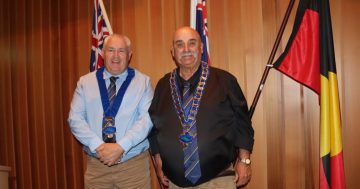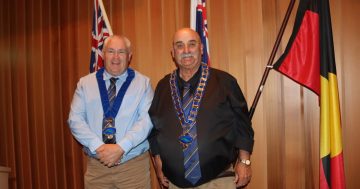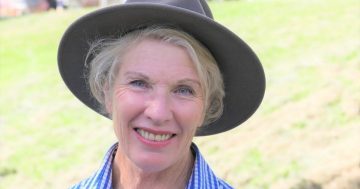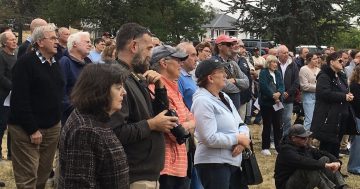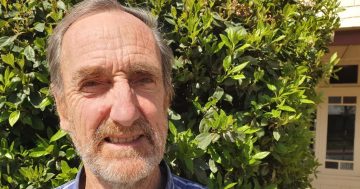
Some of the crowd of more than 50 people outside the Goulburn Mulwaree Civic Centre on Tuesday opposed to the rate hike in 2024-25. Photo: John Thistleton.
Goulburn Mulwaree Council has rejected an accountant’s claim that it is awash with millions of dollars in annual profits and cash reserves.
The assertion comes from ratepayer activist Nina Dillon who is protesting a proposed rate hike of more than 40 per cent next year which she says people can’t afford.
Addressing more than 50 people outside the Goulburn Civic Centre on Tuesday afternoon at a protest meeting, Ms Dillion distributed figures showing annual profits and tens of millions of dollars in cash and $130 million in investments accumulated over the past six years.
An accountant and former councillor, Ms Dillon said a bigger, police-sanctioned protest would be held in a week to 10 days’ time to oppose the special rate variation (SRV). The council will vote on whether to adopt the increase next month.
The council’s Chief Executive Aaron Johnson and Director Corporate Services Brendan Hollands said Ms Dillon was relying on consolidated figures, but when separated into specific funds to meet upcoming infrastructure and maintenance for water, sewerage and waste disposal, plus capital grants, the bottom line was nowhere near such a profitable position.
On its own the general fund which came from people’s rates was in deficit of more than $10 million due to years of rate pegging by the NSW Government. The general fund is for roadworks, maintenance of parks and gardens, libraries, cemeteries, swimming pools and the Goulburn Performing Arts Centre.
The other funds for water, sewage and domestic waste were profitable because they were not subject to rate pegging. Nevertheless that money was put aside for future works, including Marulan infrastructure, the senior staff said.
Ms Dillon also cited the council’s cash and investments fund, saying it held more than $130 million. “My question is why are they accruing interest, on this we earned $3.55 million in interest last year as well,” she said. “Why is that money all tied up? Why isn’t the work being done? If that is the big issue that we haven’t got enough for capital works, why aren’t these funds being spent?”
Mr Hollands and Mr Johansson gave a similar explanation to the one for the general fund – the money was held back for specific projects and included unspent capital grants. “There is about $20 million worth of unexpended grants in that figure, the bulk of it is for water and sewer (funds),” Mr Hollands said.
The figure also includes Federal Government assistance grants paid in advance which the council held in reserve, in case future grants were not forthcoming, and the money was needed. Also, in the cash and investment account was contributions from developers for planned infrastructure projects. Once all these sums were accounted for it left only $3.892 million in unrestricted money in the cash and investment fund.
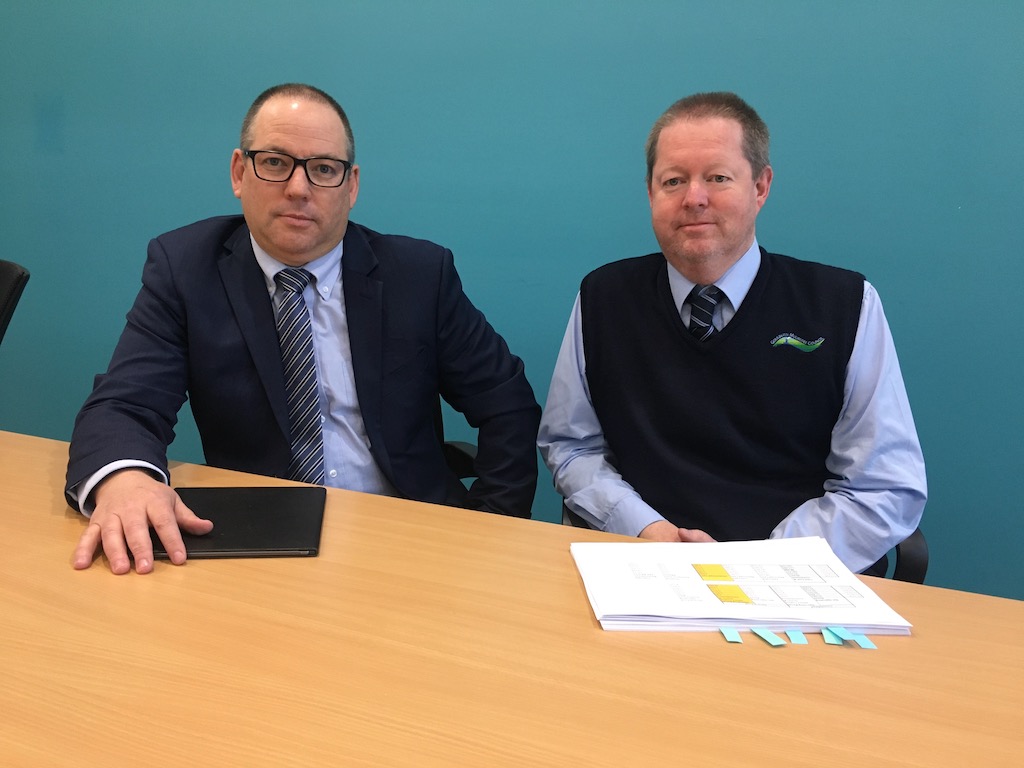
Goulburn Mulwaree Council Chief Executive Aaron Johansson and Director Corporate Services Brendan Hollands say pegged rates have not kept pace with road infrastructure. Massive cost increases in electricity, the emergency services levy, insurance, information technology and cyber security need to be funded as well. Photo: John Thistleton.
According to council, that unrestricted cash should be about $15 million, to enable the ongoing operation of the council for four months in case of a major, unforeseen issue such as storm damage, arising.
Ms Dillon said people were deeply concerned how to pay an extra $500 to $1000 or more on their annual rates.
“I have had thousands of people contact me, not hundreds, thousands,” she said. Their main concern was how they could afford such an increase.
Ms Dillon said Goulburn Mulwaree residents had significantly lower incomes, and quoted from 2021 Census figures showing the median income for residents over 18 years was only $749 a week before tax. The median household income was only $1418 a week before tax.
Mr Johansson said the council understood the proposed increase came at a difficult time for everyone. “We are in the same position as most households and most businesses,” he said. “Our costs of conducting the business of council have increased significantly.”
If the council chooses not to proceed with the rate increase it will have to cut services.
“Regardless of what council decides in the November meeting, we will continue to look at how we conduct business and look for efficiency savings for the ratepayers,” Mr Johansson said.
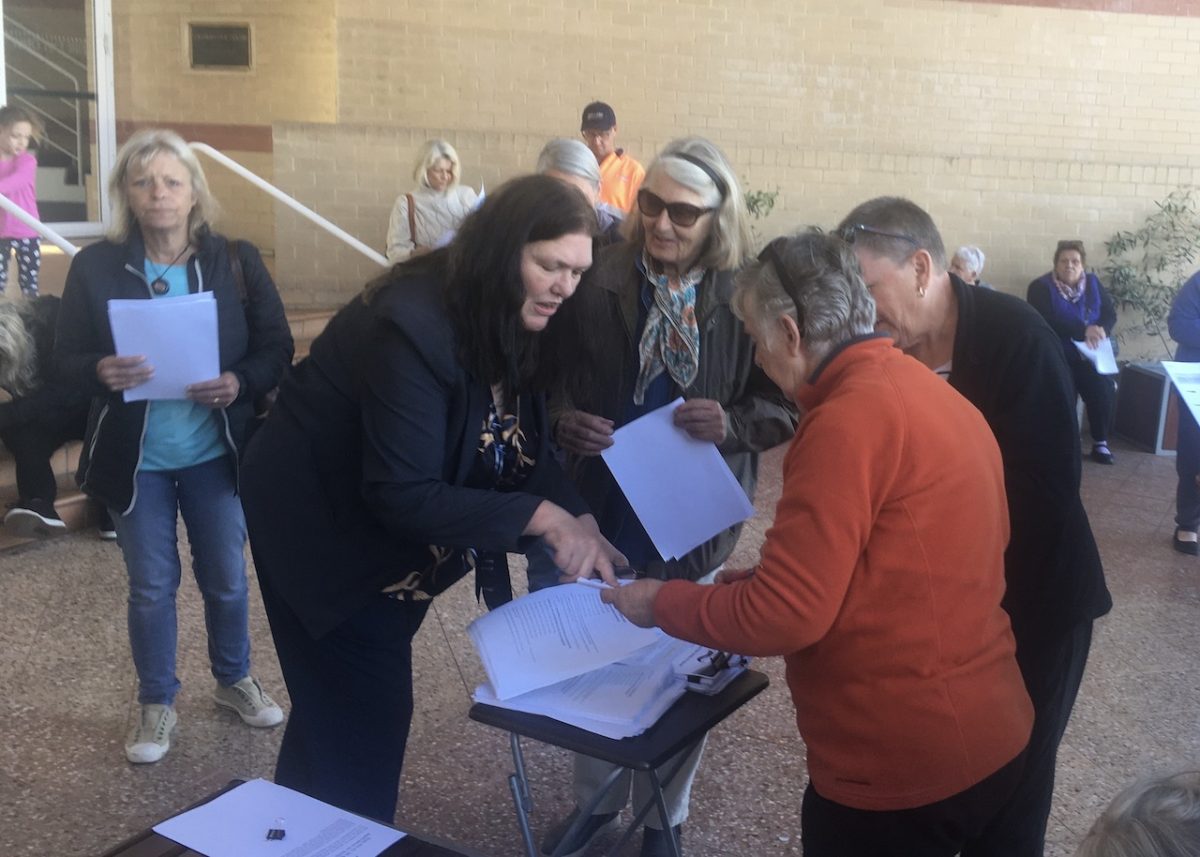
Nina Dillon (centre) pointing out some of the figures in her case for not raising rates. The Goulburn accountant is organising a petition and a bigger protest meeting. Photo: John Thistleton.
Mr Hollands said the council was projecting $10.5 million deficits in coming years. “To get to where we need to be, this rate is about $9.5 million of it, we still need to work on those efficiencies and find another $1 million ourselves.”
Mr Johansson said the degradation of roads had increased significantly, and the council faced a maintenance backlog. “This (special rate variation) is about ensuring that our infrastructure meets the needs of our community today, into the future and that’s why this whole SRV process has come about.”











